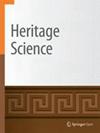曹夫人莫切墓出土金银鼻饰43件的研究与思考
IF 2.6
1区 艺术学
Q2 CHEMISTRY, ANALYTICAL
引用次数: 0
摘要
作者研究了43件美丽的鼻饰,这些鼻饰来自秘鲁北部曹夫人的莫切墓,其年代约为公元前300-400年。在这些物品中,有39件是由金合金片以各种方式与银合金片结合在一起组成的,这在它们的界面上提供了强烈的对比。两个鼻饰在金合金上,两个在银合金上。采用以下方法对这些鼻饰进行了研究:(i)能量色散x射线荧光(EDXRF);(ii)单能x射线传输(XRT)和(iii) x射线照相(RAD)。从所有应用的方法中得出的结论是,两块金和银合金是用各种方法连接在一起的,包括胶水、机械连接、焊接、借助加热熔炼或使用汞来制造汞合金。不能排除从Au-Cu-Ag基合金中通过耗尽镀银获得的少数明显呈现为银的区域。通过分析一个鼻饰银色区域的碎片,以及对曹夫人墓中其他一些鼻饰的原位研究,G. Ingo及其同事得出结论,这是一种独特的三组分合金(Ag-Cu-Au),通过消耗镀金和镀银,它利用并改变了物体表面,使其看起来像是金和银。本文章由计算机程序翻译,如有差异,请以英文原文为准。
Studies and Considerations on Forty-Three Gold and Silver Nose Ornaments from the Moche Tomb of the Lady of Cao
The authors studied forty-three beautiful nose ornaments from the Moche tomb of the Lady of Cao, located in the north of Peru, which has been dated to be around 300–400 d.C. Of these items, thirty-nine are composed of a sheet of gold alloy joined together in various manners to a silver alloy sheet, which provides a strong contrast at their interface. Two nose ornaments are on gold alloy and two on silver alloy. These nose ornaments were studied using the following methods: (i) Energy-dispersive X-ray fluorescence (EDXRF); (ii) Transmission of monoenergetic X-rays (XRT) and (iii) X-ray Radiography (RAD). The conclusion, deduced from all applied methods, was that two sheets of gold and silver alloys were joined together with various methods, including gluing, mechanically joining, soldering, smelting with the aid of heating or using mercury to create an amalgam. It cannot be excluded that a few areas, visibly appearing as silver, were obtained by depletion silvering from the base Au-Cu-Ag alloy. By analyzing a fragment from the silver area of a nose ornament and by studying a few other nose ornaments from the tomb of the Lady of Cao in situ, G. Ingo and co-workers concluded that a unique sheet of three-component alloy (Ag-Cu-Au), whichemployed and transformed the surface of the objects to appear to be gold and silver by depletion gilding and silvering.
求助全文
通过发布文献求助,成功后即可免费获取论文全文。
去求助
来源期刊

Heritage Science
Arts and Humanities-Conservation
CiteScore
4.00
自引率
20.00%
发文量
183
审稿时长
19 weeks
期刊介绍:
Heritage Science is an open access journal publishing original peer-reviewed research covering:
Understanding of the manufacturing processes, provenances, and environmental contexts of material types, objects, and buildings, of cultural significance including their historical significance.
Understanding and prediction of physico-chemical and biological degradation processes of cultural artefacts, including climate change, and predictive heritage studies.
Development and application of analytical and imaging methods or equipments for non-invasive, non-destructive or portable analysis of artwork and objects of cultural significance to identify component materials, degradation products and deterioration markers.
Development and application of invasive and destructive methods for understanding the provenance of objects of cultural significance.
Development and critical assessment of treatment materials and methods for artwork and objects of cultural significance.
Development and application of statistical methods and algorithms for data analysis to further understanding of culturally significant objects.
Publication of reference and corpus datasets as supplementary information to the statistical and analytical studies above.
Description of novel technologies that can assist in the understanding of cultural heritage.
 求助内容:
求助内容: 应助结果提醒方式:
应助结果提醒方式:


